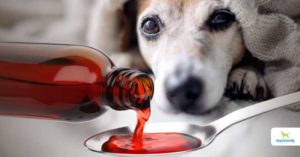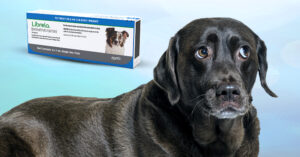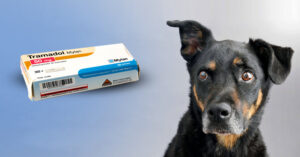Most people are aware of the dangers of antibiotics, even those who advocate them. Most vets and pet owners have learned that these medications create antibiotic resistance and destroy the healthy flora in the gut.
About 10 years ago, microbiologist Thad Stanton led a USDA study. He discovered that not only does antibiotic use in pigs change the bacterial flora in the gut, but even low doses of the drug given for only two weeks also caused a drastic increase in the number of E-coli bacteria in the gut … the opposite effect they had expected. And those bacteria showed a large jump in resistance to antibiotics.
Antibiotic resistance in dogs is something you need to know about … so here’s some background on this troubling phenomenon that affects humans and animals alike.
The Discovery Of Antibiotic Resistance
The warning bells about antibiotic resistance first rang in the 1970s when the late microbiologist Stuart Levy published studies about how the use of antibiotics in chicken feed led to antibiotic-resistant bacteria that could actually be spread to the microbiome of farmers and beyond.
This information raised the ire of those in animal production and pharmaceutical companies and so further studies were limited. Levy believed “… industry didn’t want more studies. They were upset that our data showed them to be wrong. This was highly political.”
What Are Antibiotics?
In the 1920s Sir Alexander Fleming accidentally discovered penicillin which was to be the first mass-produced antibiotic. During World War II. penicillin was used to treat wounds with risk of bacterial infection that could lead to death. It saved tens of thousands of lives.
In the decades since, antibiotics have become powerful, lifesaving medicines used to treat illnesses and infections caused by specific bacteria in humans and animals … including your dog. They kill bacteria … but not viruses or fungus. They’re most often used to treat urinary, respiratory and digestive infections and specific symptoms like diarrhea, ear and sinus issues. And they’ve become very commonplace in their use.
But as we learn more about the immune system and the microbiome, it’s becoming equally well-known that antibiotics don’t just kill the bacteria that cause infection. Antibiotics kill ALL bacteria … even beneficial bacteria in the gut that aid in digestion, produce vitamins, help in hormone production and destroy harmful bacteria. Without these friendly bacteria, your dog can contract a long-term illness or develop chronic disease that’s hard to treat.
What Are Antibiotic-Resistant Bacteria?
Antibiotic resistance happens when bacteria don’t respond to the antibiotics designed to kill them. This creates a superbug so stronger antibiotics are produced. And even then, they don’t work on these new strains of bacteria. So bacteria are not killed and these types of bacterial infections in dogs continue to spread. It’s the bacteria that resist the antibiotics, not the body.
In 2013, the Centers For Disease Control (CDC) published a paper on the seriousness of antibiotic resistance threats. They call antibiotic resistance “one of the biggest public health challenges of our time […] Fighting this threat is a public health priority that requires a collaborative global approach across sectors.”
Antibiotic resistance is a natural phenomenon. Bacteria naturally find new ways to avoid the effects of the antibiotics used for the infections they cause.
According to Dr Richard S Patton PhD, antibiotic-resistant bacteria are doing what any species is designed to do. “The two irreducible pillars of existence for any species are first, survival and second, reproduction.” (6) And just as mammals adapt to shortages of water and food with digestive tracts and enzymes needed to consume and survive on the food sources available, bacteria also engage in survivor mode and become resistant to antibiotics.
This concept was echoed by the CDC in 2013: “Because antibiotic resistance occurs as part of a natural evolution process, it can be significantly slowed but not stopped. Therefore, new antibiotics will always be needed to keep up with resistant bacteria.”
As early as 1945, Fleming issued a warning about antibiotic overuse with these words: “… the public will demand [the drug and] … then will begin an era … of abuses.”
The world has known about antibiotic resistance for almost 50 years and yet today, they are still prescribed with little hesitation. The World Health Organization (WHO) and the CDC lead the way with warnings about limiting the use of antibiotics and are the first to admit their abuse.
Causes Of Antibiotic Resistance
What started as a lifesaving solution to infection, soon became a source of a bigger problem. Here are causes of antibiotic resistance:
- Over-prescribing of antibiotics
- Prescribing antibiotics unnecessarily or without proper bacteria testing
- Prescribing antibiotics beyond the scope of what is needed
- Patients who fail to finish an entire course of antibiotics so remaining bacteria can become a “superbug” and resist future antibiotics
- Overuse of antibiotics in livestock and fish farming operations
- Poor infection control in hospitals and health care facilities
- Poor hygiene and sanitation
- Failure to develop new antibiotics
In 2020, the WHO declared antimicrobial (formerly antibiotic) resistance “one of the top 10 global public health threats facing humanity.” It cited misuse and overuse of antibiotics as the source of drug-resistant pathogens.
“The world urgently needs to change the way it prescribes and uses antibiotics. Even if new medicines are developed, without behavior change, antibiotic resistance will remain a major threat…. Where antibiotics can be bought for human or animal use without a prescription, the emergence and spread of resistance are made worse.”
A 2015 report, The Antibiotic Resistance Crisis, states: “The antibiotic resistance crisis has been attributed to the overuse and misuse of these medications, as well as a lack of new drug development by the pharmaceutical industry due to reduced economic incentives and challenging regulatory requirements.” According to the report and data from the CDC and FDA, new antibiotics approved for use have steadily decreased since 1985 while approval for cancer drugs has risen.
In 2017, the cost of developing an antibiotic was about $1.5 billion but the return on investment was only $46 million. In contrast, the low cost of antibiotics generally priced at $1,000 to $3,000 for a course is considerably less than chemotherapy that can cost tens of thousands of dollars. A drug used to treat a neuromuscular disease could be valued as high as $1 billion. Also, when infectious disease specialists and institutions like the CDC and WHO advise minimizing the use of antibiotics, the monetary incentive to develop new drugs is even less.
How Do Antibiotic-Resistant Bacteria Spread?
For 50 years it’s been known that antibiotic use in livestock increases the risk of antibiotic resistance in humans. Bacteria are passed through the animal waste from large-scale animal farms. The resistant bacteria infect the microbiomes of farmers and workers who come in contact with them. Bacteria also travels through fish farming operations and through the wastewater from antibiotic manufacturing, hospitals and municipalities as antibiotic pollution. Humans and animals taking antibiotics excrete both the antibiotics and bacteria in feces and urine, passing on the genes to other animals and microbes in the environment.
Antibiotic Resistance In Dogs
Antibiotic resistance affects dogs as well as people and other animals. Several studies show that drug resistant bacterial infections like MRSA (staph infection) are on the rise in dogs. In 2010, researchers at Canada’s University of Guelph found that “… MRSA is an emerging pathogen in dogs, and risk factors for MRSA infection are similar to those identified in humans.” And, as you’ll read later, there’s a suggestion dogs may share this antibiotic resistance with the people they live with.
Over-prescribing of antibiotics is widespread. The American Veterinary Medical Association’s (AVMA) Task Force For Antimicrobial Stewardship in Companion Animals said it “seems likely” that the amount of unnecessary use of antibiotics in companion animal settings is close to 50% . That’s a shockingly high number. And with a lot of dog antibiotics not working … it’s a frightening trend.
Dogs are often given antibiotics for urinary, respiratory and skin infections. A problem like antibiotic-resistant UTI in dogs is widespread. Misuse happens when the wrong antibiotic is chosen … or a stronger or broader-spectrum antibiotic is given when a narrower scope of treatment would do. Often antibiotics are prescribed without test results. Some owners may pressure vets for a prescription, or an antibiotic is given to rule out the cause of illness … or “just in case.”
How Antibiotic Resistance Spreads To Humans
This has brought into question the spread of antibiotic resistance between companion animals and humans. In this 2020 study, researchers looked at 303 dogs and cats for a year in three European countries. They reported studies confirming there was already high use of broad-spectrum antimicrobials that were often not in line with current European guidelines. They found that while antibiotic use in pets was lower than in farming operations, there was a high use of “critically important antimicrobials” … meaning stronger antibiotics.
They concluded antibiotic use “does not lie so much within the quantity but rather within the quality of antimicrobials used. Especially from a One-Health perspective, companion animals might be a source of transmission of resistance genes and/or resistant bacteria to humans. At the country level, higher resistance in companion animals seems to follow trends of higher antimicrobial use.”
Antibiotic Resistant Bacteria In Foods
The food system is another way antibiotic resistance affects dogs.
In Aug 2021 The American Kennel Club asked: “Why do so many meat products contain antibiotic-resistant bacteria?” And it responded with: “The answer comes down to the food-production system, in which many animals reared for consumption are pumped full of antibiotics, allowing bacteria to mutate and become resistant. And this isn’t restricted to animals raised to feed dogs.” In other words, the human food chain has not been protected … which isn’t surprising given that about 80% of antibiotics in the US are said to be used in livestock.
Researcher Dr Ana Freitas told the AKC that the food-production system itself needs to be addressed. “Authorities should review the production circuit of dog food, from the selection of raw materials to manufacturing and hygiene practices.”
Is There An Alternative To Antibiotics?
Not using them in farming operations is one solution that could make a big difference.
In 2003, the WHO reported on Denmark’s termination of antibiotic use on industrial farms. It stated the “phasing out of non-therapeutic use of antibiotics for growth promotion has not caused any negative impact on food animal production in Denmark. In fact, the industry’s productivity has increased as well as its output.” The WHO added, “the routine non-therapeutic use of antimicrobials should never be a substitute for good animal health management.”
For several decades, scientific reports have been advocating more research into alternatives to antibiotic use.
CH Wang et al explored options in a 2020 study: “There is thus an emergent need for both novel classes of antibiotics and novel approaches to treatment, including the repurposing of existing drugs or preclinical compounds and expanded implementation of combination therapies.” They also advise monitoring the prescribing of antibiotics and their use to delay the spread of antibiotic-resistant organisms.
Microbiologist Stanton noted the lack of interest in developing new antibiotics shortly after his USDA study described earlier. In his 2013 report he called for “innovative and bold solutions to slow resistance to antibiotics and speed the development of new antibacterials… We have to be judicious in antibiotic use.”
As the Levy studies showed in the 1970s, farm animals given antibiotics led to an increase in antibiotic resistance in animals taking the drugs as well as in people working on the farms where those animals live. Even when farmers stop using the drugs, resistance persists for years, as mothers pass their drug-resistant flora down to their offspring for generations. And the resistant bacteria continues to spread through feces and manure to other farms, animals and people.
The same thing could be happening in your yard, parks or dog boarding and training facilities where the feces are tracked by you, your dog and even your children …as well as birds and other animals. And if you’re a cat owner, think about your cat using the litter box then jumping on the kitchen counter!
Dog owners can minimize or eliminate antibiotic use. Ensure your dog has a healthy immune system with a whole food, meat-based diet and pre- and probiotics to support his microbiome. Then if he gets a mild infection, he should be able to fight it off with the help of natural antibiotic alternatives. Antibiotics are not an ideal solution as they could be creating greater health risks for your dog.
And if your vet prescribes antibiotics, ask if they’re really necessary. Look for alternatives that can treat your dog without damaging his microbiome and contributing to antibiotic resistance in dogs. Save antibiotics for serious situations where nothing else will do.
References
1. Levy, SB, et al. Changes in Intestinal Flora of Farm Personnel after Introduction of a Tetracycline-Supplemented Feed on a Farm. N Engl J Med. 295:583–588. 1976.
2. Levy, S, et al. Spread of antibiotic-resistant plasmids from chicken to chicken and from chicken to man. Nature. 260, 40–42. 1976.
3. https://www.the-scientist.com/profile/resistance-fighter-35388
4. Centers for Disease Control and Prevention. Antibiotic resistance threats in the United States, 2013. U.S. Dept of Health and Human Services. CDC. 2013.
5. https://www.cdc.gov/drugresistance/resources.html
6. Patton PhD, Richard S. Ruined By Excess, Perfected By Lack. The Paradox Of Pet Nutrition. DN Publishing. 2017.
7. Ventola CL. The antibiotic resistance crisis: part 1: causes and threats. P&T. 40(4):277-83. Apr 2015.
8. https://www.who.int/news-room/fact-sheets/detail/antimicrobial-resistance
9. Adrian Towse, et al. Time for a change in how new antibiotics are reimbursed: Development of an insurance framework for funding new antibiotics based on a policy of risk mitigation, Health Policy. Volume 121, Issue 10, 2017, Pages 1025-1030.
10. Faires MC, Traverse M, Tater KC, Pearl DL, Weese JS. Methicillin-resistant and -susceptible Staphylococcus aureus infections in dogs. Emerg Infect Dis. 2010;16(1):69-75.
11. Bender, JB. The AVMA Task Force for Antimicrobial Stewardship in Companion Animal Practice responds. JAVMA. 246(7):727-8, April 2015.
12. Joosten P, et al. Antimicrobial Usage and Resistance in Companion Animals: A Cross-Sectional Study in Three European Countries. Antibiotics (Basel). 16;9(2):87. 2020 Feb.
13. Robins, Mary. Raw Dog Food May Be Fueling Rise in Antibiotic-Resistant Bacteria. AKC. Aug 2021.
14. The Pew Charitable Trusts. Avoiding Antibiotic Resistance: Denmark’s Ban on Growth Promoting Antibiotics in Food Animals. The Pew Campaign on Human Health and Industrial Farming
15. Wang CH, et al. Defeating Antibiotic-Resistant Bacteria: Exploring Alternative Therapies for a Post-Antibiotic Era. Int J Mol Sci. 5;21(3):1061. 2020 Feb.
16. Stanton, TB. A call for antibiotic alternatives research. Science & Society. Vol 21, Issue 3, P111-113, March 01, 2013.
Additional Reading
Antibiotic resistance in pets an increasing problem. Center for Infectious Disease Research and Policy. Aug 2016.
Casaburi G, Duar RM, Vance DP, Mitchell R, Contreras L, Frese SA, Smilowitz JT, Underwood MA. Early-life gut microbiome modulation reduces the abundance of antibiotic-resistant bacteria. Antimicrob Resist Infect Control. 14;8:131. Aug. 2019
Pamer EG. Resurrecting the intestinal microbiota to combat antibiotic-resistant pathogens. Science. 29;352(6285):535-8. Apr 2016.
United Nations meeting on antimicrobial resistance. Bull World Health Organ. 1;94(9):638-639. Sep 2016.
Panwar, R.B., Sequeira, R.P. & Clarke, T.B. Microbiota-mediated protection against antibiotic-resistant pathogens. Genes Immun. 22, 255–267. 2021.












